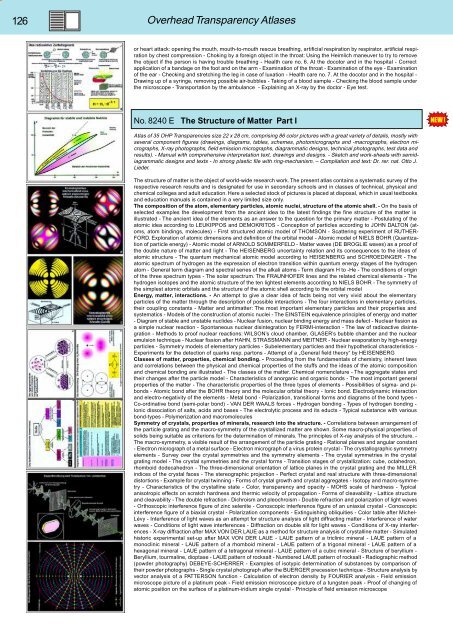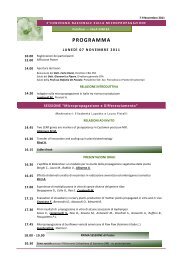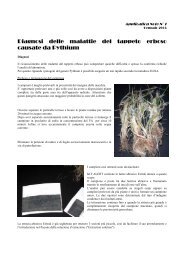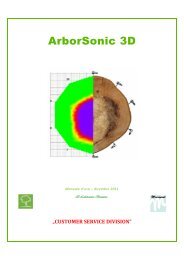BIOLOGY - microscopia.info
BIOLOGY - microscopia.info
BIOLOGY - microscopia.info
You also want an ePaper? Increase the reach of your titles
YUMPU automatically turns print PDFs into web optimized ePapers that Google loves.
126<br />
Overhead Transparency Atlases<br />
or heart attack: opening the mouth, mouth-to-mouth rescue breathing, artificial respiration by respirator, artificial respiration<br />
by chest compression - Choking by a foreign object in the throat: Using the Heimlich maneuver to try to remove<br />
the object if the person is having trouble breathing - Health care no. 6. At the docotor and in the hospital - Correct<br />
application of a bandage on the foot and on the arm - Examination of the throat - Examination of the eye - Examination<br />
of the ear - Checking and stretching the leg in case of luxation - Health care no. 7. At the docotor and in the hospital -<br />
Drawing up of a syringe, removing possible air-bubbles - Taking of a blood sample - Checking the blood sample under<br />
the microscope - Transportation by the ambulance - Explaining an X-ray by the doctor - Eye test.<br />
No. 8240 E The Structure of Matter Part I<br />
Atlas of 35 OHP Transparencies size 22 x 28 cm, comprising 86 color pictures with a great variety of details, mostly with<br />
several component figures (drawings, diagrams, tables, schemes, photomicrographs and -macrographs, electron micrographs,<br />
X-ray photographs, field emission micrographs, diagrammatic designs, technical photographs, test data and<br />
results). - Manual with comprehensive interpretation text, drawings and designs. - Sketch and work-sheets with semidiagrammatic<br />
designs and texts - In strong plastic file with ring-mechanism. – Compilation and text: Dr. rer. nat. Otto J.<br />
Lieder.<br />
The structure of matter is the object of world-wide research work. The present atlas contains a systematic survey of the<br />
respective research results and is designated for use in secondary schools and in classes of technical, physical and<br />
chemical colleges and adult education. Here a selected stock of pictures is placed at disposal, which in usual textbooks<br />
and education manuals is contained in a very limited size only.<br />
The composition of the atom, elementary particles, atomic nuclei, structure of the atomic shell. - On the basis of<br />
selected examples the development from the ancient idea to the latest findings the fine structure of the matter is<br />
illustrated - The ancient idea of the elements as an answer to the question for the primary matter - Postulating of the<br />
atomic idea according to LEUKIPPOS and DEMOKRITOS - Conception of particles according to JOHN DALTON (atoms,<br />
atom bindings, molecules) - First structured atomic model of THOMSON - Scattering experiment of RUTHER-<br />
FORD. Exploration of atomic dimensions and definition of the orbital model - Atomic model of NIELS BOHR (Quantization<br />
of particle energy) - Atomic model of ARNOLD SOMMERFELD - Matter waves (DE BROGLIE waves) as a proof of<br />
the double nature of matter and light - The HEISENBERG uncertainty relation and its consequences to the ideas of<br />
atomic structure - The quantum mechanical atomic model according to HEISENBERG and SCHROEDINGER - The<br />
atomic spectrum of hydrogen as the expression of electron transition within quantum energy stages of the hydrogen<br />
atom - General term diagram and spectral series of the alkali atoms - Term diagram H to -He - The conditions of origin<br />
of the three spectrum types - The solar spectrum. The FRAUNHOFER lines and the related chemical elements - The<br />
hydrogen isotopes and the atomic structure of the ten lightest elements according to NIELS BOHR - The symmetry of<br />
the simplest atomic orbitals and the structure of the atomic shell according to the orbital model<br />
Energy, matter, interactions. - An attempt to give a clear idea of facts being not very vivid about the elementary<br />
particles of the matter through the description of possible interactions - The four interactions in elementary particles,<br />
their coupling constants - Matter and antimatter: The most important elementary particles and their properties and<br />
systematics - Models of the construction of atomic nuclei - The EINSTEIN equivalence principles of energy and matter<br />
- Diagram of stable and unstable nuclides - Nuclear fusion, nuclear binding energy and mass defect - Nuclear fission as<br />
a simple nuclear reaction - Spontaneous nuclear disintegration by FERMI-interaction - The law of radioactive disintegration<br />
- Methods to proof nuclear reactions: WILSON’s cloud chamber, GLASER’s bubble chamber and the nuclear<br />
emulsion technique - Nuclear fission after HAHN, STRASSMANN and MEITNER - Nuclear evaporation by high-energy<br />
particles - Symmetry models of elementary particles - Subelementary particles and their hypothetical characteristics -<br />
Experiments for the detection of quarks resp. partons - Attempt of a „General field theory“ by HEISENBERG<br />
Classes of matter, properties, chemical bonding. - Proceeding from the fundamentals of chemistry, inherent laws<br />
and correlations between the physical and chemical properties of the stuffs and the ideas of the atomic composition<br />
and chemical bonding are illustrated - The classes of the matter. Chemical nomenclature - The aggregate states and<br />
their changes after the particle model - Characteristics of anorganic and organic bonds - The most important general<br />
properties of the matter - The characteristic properties of the three types of elements - Possibilities of sigma- and pibonds<br />
- Atomic bond after the BOHR theory and the molecular orbital theory - Ionic bond. Electrodynamic interaction<br />
and electro-negativity of the elements - Metal bond - Polarization, transitional forms and diagrams of the bond types -<br />
Co-ordinative bond (semi-polar bond) - VAN DER WAALS forces - Hydrogen bonding - Types of hydrogen bonding -<br />
Ionic dissociation of salts, acids and bases - The electrolytic process and its educts - Typical substance with various<br />
bond-types - Polymerization and macromolecules<br />
Symmetry of crystals, properties of minerals, research into the structure. - Correlations between arrangement of<br />
the particle grating and the macro-symmetry of the crystallized matter are shown. Some macro-physical properties of<br />
solids being suitable as criterions for the determination of minerals. The principles of X-ray analysis of the structure. -<br />
The macro-symmetry, a visible result of the arrangement of the particle grating - Rational planes and angular constant<br />
- Electron micrograph of a metal surface - Electron micrograph of a virus protein crystal - The crystallographic symmetry<br />
elements - Survey over the crystal symmetries and the symmetry elements - The crystal symmetries in the crystal<br />
grating model - The crystal symmetries and the crystal forms - Transition stages of crystallization: cube, octahedron,<br />
rhomboid dodecahedron - The three-dimensional orientation of lattice planes in the crystal grating and the MILLER<br />
indices of the crystal faces - The stereographic projection - Perfect crystal and real structure with three-dimensional<br />
distortions - Example for crystal twinning - Forms of crystal growth and crystal aggregates - Isotopy and macro-symmetry<br />
- Characteristics of the crystalline state - Color, transparency and opacity - MOHS scale of hardness - Typical<br />
anisotropic effects on scratch hardness and thermic velocity of propagation - Forms of cleavability - Lattice structure<br />
and cleavability - The double refraction - Dichroism and pleochroism - Double refraction and polarization of light waves<br />
- Orthoscopic interference figure of zinc selenite - Conoscopic interference figure of an uniaxial crystal - Conoscopic<br />
interference figure of a biaxial crystal - Polarization components - Extinguishing obliquities - Color table after Michel-<br />
Lévy - Interference of light waves as an attempt for structure analysis of light diffracting matter - Interference of water<br />
waves - Conditions of light wave interferences - Diffraction on double slit for light waves - Conditions of X-ray interferences<br />
- X-ray diffraction after MAX VON DER LAUE as a method for structure analysis of crystalline matter - Simulated<br />
historic experimental set-up after MAX VON DER LAUE - LAUE pattern of a triclinic mineral - LAUE pattern of a<br />
monoclinic mineral - LAUE pattern of a rhomboid mineral - LAUE pattern of a trigonal mineral - LAUE pattern of a<br />
hexagonal mineral - LAUE pattern of a tetragonal mineral - LAUE pattern of a cubic mineral - Structure of beryllium -<br />
Beryllium, tourmaline, dioptase - LAUE pattern of rocksalt - Numbered LAUE pattern of rocksalt - Radiographic method<br />
(powder photography) DEBEYE-SCHERRER - Examples of isotypic determination of substances by comparison of<br />
their powder photographs - Single crystal photograph after the BUERGER precession technique - Structure analysis by<br />
vector analysis of a PATTERSON function - Calculation of electron density by FOURIER analysis - Field emission<br />
microscope picture of a platinum peak - Field emission microscope picture of a tungsten peak - Proof of changing of<br />
atomic position on the surface of a platinum-iridium single crystal - Principle of field emission microscope







